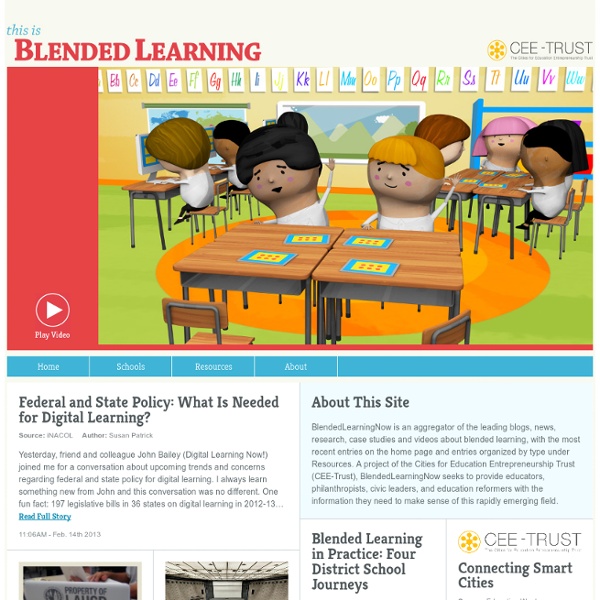



Blended Learning Toolkit | Reflecting On A Year Of Blended Learning Some of the city’s “turnaround” schools, including the one where I work, are listing knowledge or willingness to learn about using a blended learning instructional models as a criterion for hiring teachers. That’s because we are participating in the iLearn NYC program, a Department of Education initiative to support blended learning throughout the city. The initiative gives schools access to online content from various providers at a reduced cost; a learning management system to host online courses; and professional development, technical support, and training. The term “blended learning” caused a great deal of head-scratching among some staff members in my school as I’m sure it did in other turnaround schools. As the iLearn coordinator for my school, I offered answers to any questions teachers might have and there were many. Blended learning, simply defined as a combination of face to face and online instruction, is a pedagogical model that is often and easily misunderstood.
BlendKit Course: DIY Project Tasks Course Home | Schedule | Learning Activities | DIY Tasks | Readings | Blogging | Badges | Real Time Sessions/Archive | Stories About the BlendKit Course The BlendKit Course is a set of subject matter neutral, open educational resources related to blended learning and available for self-study or for group use. Periodically, these materials will also be used as the basis for a facilitated open, online course. Get on the mailing list to stay informed about BlendKit developments, including information on the next facilitated cohort. Task 01: Conceptualize Your Blended Learning Course Course Blueprint template, instructions, and sample [Word doc; size=349kb] Mix Map template and instructions [Word doc; size=45kb] Mix Map completed sample [pdf file; size=24kb] Video: Oregon State University Prof. Task 02: Design for Interaction in Your Blended Learning Course Task 03: Decide Upon Assessments of Learning in Your Blended Learning Course Task 05: Assure Quality in Your Blended Learning Course
EDge21 In the 1984 film Teachers, Royal Dano played a teacher named Ditto Stiles. Ditto was known for having virtually no interactions with his students. He had established a system by which students automatically distributed "ditto" worksheets that would be collected at the end of the class by other students. Throughout the class, Ditto would hide behind a newspaper. Ultimately, Ditto dies in the classroom, but isn't discovered until the end of the day as his students continue to follow the standard routine. If you are an educator of a certain age (as am I), you likely have many memories, both good and maybe not so good, of the “Ditto machine." In North America, "Ditto" is a brand name which was commonly used for a spirit duplicator (referred to as a Banda machine in the UK, a Roneo in France and Australia). The spirit duplicator is sometimes incorrectly referred to as a "mimeograph," which was a different, but not dissimilar process. More Ditto in Pop Culture
5 Skills for Blended-Learning Teachers -- THE Journal Blended Learning | Viewpoint 5 Skills for Blended-Learning Teachers In the seventh installment of their monthly column, blended learning experts Michael B. Horn and Heather Staker outline the five skills that will increasingly be important for many teachers in the future. By Michael Horn, Heather Staker10/04/12 As more schools adopt blended-learning models, the role of the teacher is shifting. Although it is hard to generalize across the landscape of blended learning because of the rapid pace of innovation in the models, the differences between the models, and the continued changes in technology, there are five common skills that teachers will likely need to be successful in a blended-learning environment. 1) Comfort with 'Chaos' One of the biggest shifts in a blended-learning environment is often that students will be engaged in different activities and working on different concepts and skills. About the Authors Heather Staker is a senior education research fellow at Innosight Institute.
Blended Learning | Donnell-Kay Foundation Expanding digital and online offerings can begin to alleviate significant inequities that exist within our public school system today. Some students have access to high quality teachers and a diverse array of courses and schools. Others lack access because they live in communities that struggle to attract talent or find the resources to provide the variety of options that a wealthier or larger district can offer. A shift to a blended model of learning – one that combines face to face, online and digital learning – is an important next move for our state. Click through for more on: Latest News & Reports The Colorado Summit on Blended Learning, Spring 2012 Denver Blended Learning Workshop, March 2013 What is Blended Learning? Policy Recommendations Latest News & Reports: "Blended Learning in Rural Colorado: Status & Strategies for Expansion," by Amy Murin and John Watson with the Evergreen Group for the Colorado Department of Education. Colorado Summit on Blended Learning Policy recommendations:
Learn It In 5 - Home The Reed Diaries The Definition Of Blended Learning The Definition Of Blended Learning by TeachThought Staff Blended education. Hybrid learning. Flipping the classroom. That alone is one of the major benefits of blended learning. Defining hybrid or blended education is a trickier task than one might think–opinions vary wildly on the matter. That does not mean a professor can simply start a chat room or upload lecture videos and say he is leading a hybrid classroom. Blended Learning In Action In the course of higher education, blended or hybrid learning is a snazzy, yet relatively new tool, and not all professors use it the same way. For instance, most professors in blended classrooms use some version of a course management system application to connect with students online. Even if all professors used the same platform, however, they could each integrate them into their classrooms differently. How Hybrid Classrooms Are Redefining Education “Flipping” defies these conventions. Does Blended Learning Work? Not all students learn the same way.